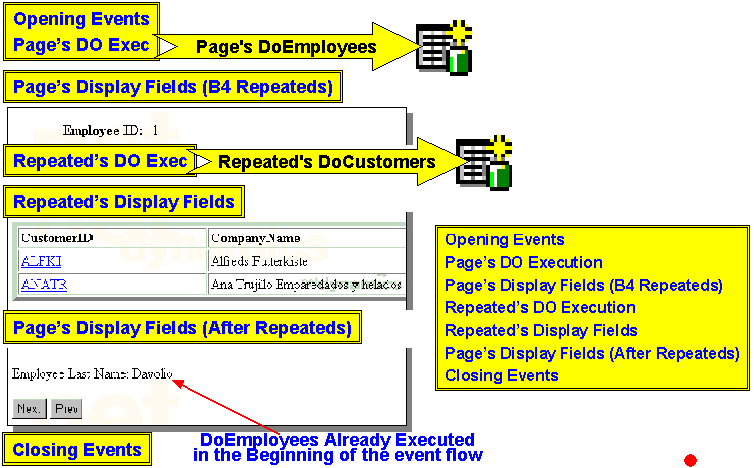The Event Model
The JDK Event Model
If we use an analogy sometimes
it is easier to understand this concept. The most common analogy used is
that of the Magazine publisher. In this model the publisher of the
magazine "advertises" the availability of the magazine to potential subscribers.
The subscribers "register" with the Publisher to receive the magazine and
the Publisher keeps a list of subscribers so that he can deliver the magazine
to them. The subscribers will "read" the magazine when it is delivered.
(Oh, come on, work with me okay?)
What are Events?
Event Objects
These are like the magazines in the analogy. These are a set of circumstances
that occur, like a button is pressed, a page is requested, the field is
displayed. These are part of the java.util.EventObject class (NetDynamics
extends this class to incorporate some of it's own specific events). These
encapsulate state change information.
Event Source Objects
These are the Publishers. They have no specific inheritance and they
are used to expose listener registration methods and to create and dispatch
events.
Listener Objects
These are the subscribers. They implement interfaces derived from java.util.EventListener
. They define event handler methods appropriate for a specific event class.
Event Interaction

Benefits of the Event Model
It is very easy to use because
it is an intuitive mapping between events and event handlers. It is scalable,
you can have many listeners registers with the same source. It is efficient
because events are only dispatched if there are registered listeners.
Most of the development
tools that use this model make event registration transparent to the developer
by using an event object the code is automatically generated to cause the
registration and dispatch to occur. It is important to note that each of
the development tools uses it own set of event types and some provide for
going beyond the predefined capabilities to take advantage of the advanced
OO (Object Oriented) design of Java itself.
Event Types in ND
Generic Events
These events are applicable to both HTML and client side Java objects (pages,
fields, etc.).
Html Only Events
These are the Project Web Processing events including page web event and
HtmlOutput events.
Client Side Java Only Events
These are standard Java 1.1 AWT events
Events can also be classified
by what they accomplish.
Initialization - typically occurring once per project initialization (page
session object initialization might be an exception)
Execution - occurring in response to user actions, like a button or a href
click
Error - these only occur when a potential error is detected by the framework
Event Flow
Because any single action can trigger many events we call this event flow.
This flow is predictable for any given page. The following graphic is a
generalized picture of a NetDynamics page event flow.

In this example the DoEmployees
is a Data Object to the database Employees. The Repeated are repeating
fields (like EmployeeLastName) that would appear in a table. The last item
is a display of a single item from the first event (which was to get the
DoEmployees) which didn't necessarily lead to the first display of information.
Contents
NetDynamics Server Architecture
State and Session Management

